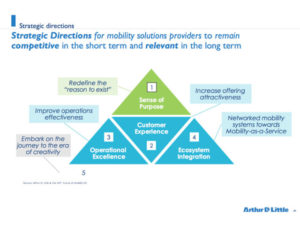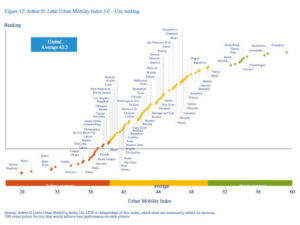A clear vision on mobility: the challenges facing our cities
A recent report by Arthur D. Little found cities still need to work intensively on improvements to their mobility systems. Francois-Joseph Van Audenhove, partner at the firm, looks at the findings.

Strategic Directions for mobility solutions providers to remain competitive in the short term and relevant in the long term
Mobility needs and behaviours are evolving. Customers now expect mobility services that are fast, reliable, convenient and personalized. In addition, recent technology developments, enabled by the fourth industrial revolution, are opening up a range of new mobility options for individuals
However, the third edition of Arthur D Little’s Urban Mobility Index found most cities still need to work intensively on improvements to their mobility systems.
The report assessed the mobility maturity, innovativeness and performances of 100 cities worldwide through 27 criteria. The global average score of the 100 cities surveyed is 42.3 out of a possible 100 points. This means that, worldwide, the average city has unleashed less than half of the potential of its urban mobility system, a state of affairs that could be remedied by applying best practices across all its operations.
Only 10 cities scored more than 50 points, of which eight are European cities and two Asian. The city-state of Singapore achieved the highest score with 59.3 points, followed by Stockholm (57.1 points), Amsterdam (56.7 points), Copenhagen (54.6 points) and Hong Kong (54.2 points). This indicates that even the highest-ranking cities have considerable potential for improvement.
Establishing a clear vision and a targeted approach
A lot of mature cities do not yet have clear visions of what their mobility systems should look like in the future or coherent strategies for getting there. In order to address future mobility challenges, cities and mobility solutions providers must adopt more comprehensive, coordinated and proactive approaches to manage mobility supply and demand. The mobility systems of tomorrow should be intermodal, personalised, convenient and connected, and encourage the use of more sustainable modes of transport (public transport, cycling, walking), while integrating new mobility solutions, such as autonomous vehicles. Convergence through digitisation constitutes a major opportunity to reinvent mobility systems as they gradually evolve to embrace “mobility-as-a-service” (MaaS), growing from the ownership of individual transport modes towards usage of multiple mobility modes as services.
At all levels, legislation is being introduced to drive change. Regulation is expected to play an important role, as it is generally geared towards creating the required framework for the sound introduction of new mobility solutions and ensuring that these will positively contribute to reaching the optimal system. It will also be a critical driver to foster sustainable innovation.
Rethinking policies and differentiating in the market
The solution for the future is an interconnected, multimodal mobility system with increased convenience and efficiency, tailored to the city’s growth project and balancing economic development and well-being. Transport authorities should address four key dimensions as they seek to rethink their sustainable mobility policies at the levels of cities and nations: a visionary strategy, mobility supply management, mobility demand management, and funding.
Mobility solutions providers – both traditional operators, as well as “new mobility” solutions providers, should consider five key dimensions when defining their visions and strategies to differentiate themselves within extended mobility ecosystems and ensure they stay competitive in the short term and relevant in the long term: a sense of purpose, branded customer experience, operational excellence, ecosystem integration towards MaaS, and transformation.
In the new report, Future of Mobility 3.0, Arthur D. Little and its partner UITP elaborate further on those dimensions and detail 12 imperatives for mobility solutions providers to consider when defining their sustainable visions and strategies. The report also includes case studies of mobility solutions providers demonstrating good practices.


